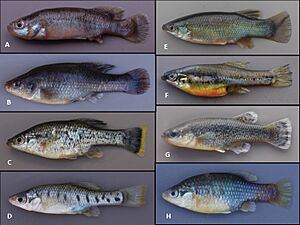Banded allotoca facts for kids
Quick facts for kids Banded allotoca |
|
|---|---|
 |
|
| Allotoca goselinei, as seen in Figure A, among other Goodeidae species. | |
| Conservation status | |
| Scientific classification |
The banded allotoca (scientific name: Allotoca goslinei) is a type of fish. People in Spanish-speaking areas sometimes call it tiro rayado. This fish belongs to a family called Goodeidae. Scientists first officially described it in 1987.
This fish used to live only in the Ameca River area in Jalisco, Mexico. Sadly, it is now extinct in the wild. This means you can no longer find it living freely in nature. The fish's scientific name, goslinei, honors an American fish expert named William A. Gosline. He studied fish like the banded allotoca.
Contents
What Does the Banded Allotoca Look Like?
Banded allotoca fish are quite small. Male fish are usually about 31.9 millimeters long. Female fish are a little bit longer, around 33.6 millimeters. That's about the length of a small paperclip!
They have two rows of cone-shaped teeth. You can tell the banded allotoca apart from other fish in its group, called Allotoca, by a few things. These include the number of bones in its spine (vertebrae). Also, the number of tiny holes above its eyes (supraorbital pores) and the number of vertical stripes on its sides are unique.
Where Did the Banded Allotoca Live?
The banded allotoca lived in the Ameca River basin in Mexico. It preferred small pools that flowed into the main river. These fish liked calm, shallow water. They often hid under algae and other floating plants.
What Did the Banded Allotoca Eat?
Scientists believe the banded allotoca mostly ate small arthropods. Arthropods are tiny creatures like insects or spiders.
How Do Male and Female Banded Allotoca Differ?
Male and female banded allotoca fish look a bit different from each other. This is called sexual dimorphism. Their colors can be different. Also, their fins are not the same length. For example, male banded allotoca have a longer top fin (dorsal fin) than females.
Why Did the Banded Allotoca Disappear?
The banded allotoca was a very special fish. It was considered an evolutionarily significant unit. This means it was unique and important for understanding how fish evolved.
When it was first found in 1987, there was only one known group of these fish. They lived in just one small stream of the Ameca River. Sadly, pollution in the water caused their numbers to drop in the 1990s.
Extinction in the Wild
Things got even worse in the 2000s. Another fish, the Xiphophorus helleri, was introduced to their habitat. This new fish likely competed with the banded allotoca for food and space. Because of these problems, the banded allotoca is now considered extinct in the wild.
The last time anyone saw these fish living freely in nature was in 2004. Surveys done in 2005 and later years found no wild populations. Luckily, there are still small groups of banded allotoca living in special care. These groups are in Mexico, the United States, and Europe. Scientists and aquarists are working to keep them safe.
See also
- Allotoca
- Allotoca maculata
- Allotoca meeki
- Goodeidae
- Goodeinae


